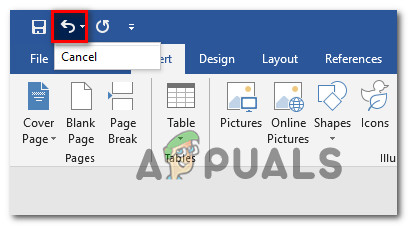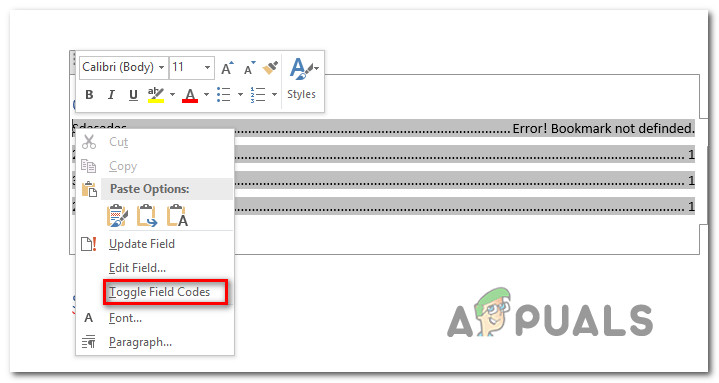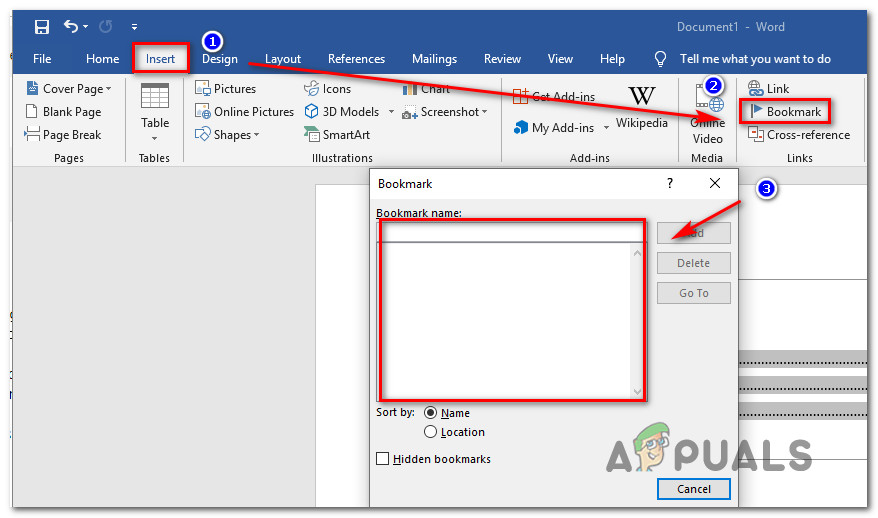Fix: Bookmark not defined on Word
Several Microsoft Office users are reporting that they are receiving the “Error! Bookmark not defined” error when trying to convert a Doc file to PDF using Microsoft Word. Whenever this happens, every page number for each item in the Table of Contents is changed from the page number to “Error! Bookmark not defined“. This particular issue is reported to occur with multiple Office versions (Office 2010 and Office 2013) and with different Windows versions (Windows 7, Windows 8.1 and Windows 10).

What is causing the “Bookmark not defined” error?
We investigated this particular issue by looking at various user reports and the repair strategies that are commonly deployed in this scenario. Based on what we gathered, there are a couple of different scenarios that will trigger this particular error message:
- One or more bookmarks are missing – In most cases, the error occurs because Microsoft Word relies on bookmarks to create the Table of Contents for various section. If one or multiple bookmarks cannot be found, you’ll get this particular error message.
- Bookmarks are outdated – If you’re working with a semi-manual ToC, chances are the Table of Content entries won’t update automatically unless you give the go-ahead that will correct the broken bookmark entries. To do this, you’ll need to select the ToC and press the F9 key.
- Bookmark entries are broken – If your .doc file contains a lot of broken links that end up triggering this particular issue, the most efficient way that will allow you to get rid of the issue is to convert the whole TOC to static text.
If you’re currently looking for ways to resolve the “Bookmark not defined” error, this article will provide you with several different troubleshooting steps. Down below, you’ll find several different methods that other users in a similar scenario have successfully used to get the issue resolved and convert their .doc files to PDF without encountering the error message.
Since the methods below are ordered by efficiency and severity, we encourage you to follow them in the order that they are presented in order to minimize your troubleshooting time.
Method 1: Using the Undo command
If you’re getting this error while trying to use an automated Table of Content (ToC), chances are one or more fields contain a broken link leading to a bookmark.
If you see the “Error! Bookmark Not Defined.” immediately after you generate the TOC and you haven’t saved the document yet, you can restore the original text easily by pressing the Ctrl + Z key combination immediately.

You can also access the Undo function by using the Ribbon menu at the top of the screen. After the action is reverted, fix the broken bookmark links before trying to convert the document to a PDF file once again.
If this method didn’t allow you to circumvent the “Error! Bookmark Not Defined.” issue, move down to the next method below.
Method 2: Replacing the missing bookmarks
If your document doesn’t use the built-in heading styles or you have made relatively new changes that ended up triggering the “Error! Bookmark Not Defined.” error, chances are you will be able to resolve the issue by transforming your Table of Contents into a semi-manual listing and replace the missing bookmarks (or change the references from inside).
Here’s a quick guide on how to do this:
- Inside your Word version, go to the TOC section and right-click on an entry that is showing the “Error! Bookmark Not Defined.”. Then, select Toggle Field Codes from the context menu.

Toggling the Field code of the failing Table of Contents entry - After you’ve done this, you will see the Field Codes behind the bookmark. HYPERLINK (or PAGEREF) is the name of the bookmark that the field currently points to. Regardless of the type of entry, the bookmark no longer exists in the document (that’s why you’re encountering the issue). To resolve the issue, use the ribbon menu to select Insert > Bookmark and create a new bookmark with the old name.

Adding the missing bookmark Note: An entry like PAGEREF/HYPERLINK ‘Bookmark Name’ points towards a bookmark inserted by hand while an entry like PAGEREF/HYPERLINK ‘Ref33958203840’ points to a hidden bookmark created by a cross-reference dialog.
- Once every missing or corrupt bookmark has been repaired, attempt to convert the document to a PDF once again and see if the issue has been resolved.
If you’re still encountering the “Error! Bookmark Not Defined.”, move down to the next method below.+
Method 3: Forcing the Table of Contents to update
If Method 1 & Method 2 has allowed you to identify the broken TOC entries and you manage to fix them, you can restore the automating updating function of the TOC by pressing F9 while the Table of Contents is selected.
Several affected users have reported that the TOC has started to update normally after they removed any broken bookmark links and pressed the F9 key. Try doing this and see if you manage to resolve your issue.
If the “Error! Bookmark Not Defined.” issue is still occurring, move down to the next method below.
Method 4: Converting the TOC to static text
If your Table of Contents has a lot of broken links and you’re not prepared to fix every entry, a quick fix to the “Error! Bookmark Not Defined.” error is to convert the automated Table of Contents to static text. This will eliminate the error and will let you override the “Error! Bookmark Not Defined.” entries with your own text.
To convert the TOC (Table of Contents) to a fully static text, all you need to do is select the TOC and press Ctrl + Shift + F9. After you do this, all your TOC entries will be transformed into static text that you can edit as you see fit.






